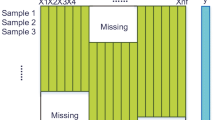Abstract
For each Rasch (Masters) partial credit item, there exists a set of independent Rasch binary and indecomposable trinary items for which the sum of the scores and the partial credit score have identical probability density functions. If each indecomposable trinary item is further expressed as the sum of two binary items, then the binary items are positively dependent and cannot be both of the Rasch type.
Similar content being viewed by others
References
Andersen, E. B. (1966).Den diskrete malingsmodel af endelig orden med anvendelse pa et socialpsykologisk materiale [A discrete latent trait model for ordered categories with applications to social psychology data]. Kobenhavn, Denmark: Statens Trykningskontor.
Andrich, D. (1978). A rating formulation for ordered response categories.Psychometrika, 43, 561–573.
Bock, R. D. (1972). Estimating item parameters and latent ability when responses are scored in two or more latent categories.Psychometrika, 37, 29–51.
Burnside, W. S., & Panton, A. W. (1892).Theory of equations (3rd ed.). Dublin: Dublin University Press Series.
Fischer, G. H. (1974).Einführung in die theorie psychologisher tests. Grundlagen und Anwendungen [Introduction to the theory of psychological tests. Foundations and applications]. Bern: Huber.
Holland, P. W. (1990). On the sampling theory foundation of item response theory models.Psychometrika, 55, 577–601.
Huynh, H. (1994). On equivalence between a partial credit item and a set of independent Rasch binary items.Psychometrika, 59, 111–119.
Huynh, H., & Ferrara, S. F. (1994). A comparison of equal percentile and partial credit equatings for performance-based assessments comprised of free-response items.Journal of Educational Measurement, 31, 125–141.
IMSL (1987).User's manual: Math/library—FORTRAN subroutines for mathematical applications. Houston: Author.
Masters, G. N. (1982). A Rasch model for partial credit scoring.Psychometrika, 47, 149–174.
Muraki, E. (1990). Fitting a polytomous item response model to Likert-type data.Applied Psychological Measurement, 14, 59–71.
Muraki, E. (1992). A generalized partial credit model: Application of an EM algorithm.Applied Psychological Measurement, 16, 159–176.
Rasch, G. (1960).Probabilistic models for some intelligence and attainment tests. Copenhagen: Danish Institute for Educational Research.
Rasch, G. (1961). On general laws and the meaning of measurement in psychology.Proceedings of the IV Berkeley Symposium on mathematical statistics and probability (Vol. 4). Berkeley: University of California Press.
Rasch, G. (1967a). An informal report on a theory of objectivity in comparisons. In L. J. Th. van der Kamp & C. A. J. Vlek (Eds.),Measurement theory. Proceedings of the NUFFIC international summer session in science in “Het Oude Hof”, The Hague, July 14–28, 1966. Leyden: University of Leyden.
Rasch, G. (1967b). An individual-centered approach to item analysis with two categories of answers. In L. J. Th. van der Kamp & C. A. J. Vlek (Eds.),Measurement theory. Proceedings of the NUFFIC international summer session in science in “Het Oude Hof”, The Hague, July 14–28, 1966. Leyden: University of Leyden.
Samejima, F. (1972). A general model for free-response data.Psychometric Monograph, No. 18.
Serret, J. A. (1928).Cours d'algèbre supérieure (7th ed.). Paris, France: Gauthier-Villars.
Thissen, D., & Steinberg, L. (1984). A response model for multiple-choice items.Psychometrika, 49, 501–519.
Wilson, M. (1988). Detecting and interpreting item local dependence using a family of Rasch models.Applied Psychological Measurement, 12, 353–364.
Wright, B. D., & Masters, G. N. (1982).Rating scale analysis. Chicago: Mesa Press.
Yen, W. M. (1993). Scaling performance assessments: Strategies for managing local item dependence.Journal of Educational Measurement, 30, 187–213.
Author information
Authors and Affiliations
Additional information
This paper was written while the author was working with Steve Ferrara and Hillary Michaels on some technical aspects of the Maryland School Performance Assessment Program. The author had been puzzled by the fact that most MSPAP assessment items have three or less score categories. With a psychometric justification now being apparent, this paper is dedicated to both of them.
Rights and permissions
About this article
Cite this article
Huynh, H. Decomposition of a Rasch partial credit item into independent binary and indecomposable trinary items. Psychometrika 61, 31–39 (1996). https://doi.org/10.1007/BF02296957
Received:
Revised:
Issue Date:
DOI: https://doi.org/10.1007/BF02296957




